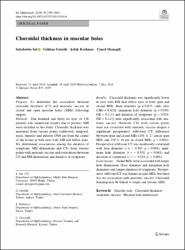Choroidal thickness in macular holes
Abstract
Purpose To determine the association between choroidal thickness (CT) and anatomic success in closed and open macular holes (MHs) following surgery. Methods One hundred and thirty-six eyes of 136 patients who underwent surgery due to primary MH were included in this study. Choroidal thickness was measured from various points (subfoveal, temporal, nasal, superior and inferior 1500 mu m from the center of the fovea) in both eyes with MH and fellow eyes. We determined associations among the duration of symptoms, MH dimensions and CTs from various points with anatomic success and correlations between CT and MH dimensions and duration of symptoms. Results Choroidal thickness was significantly lower in eyes with MH than fellow eyes in both open and closed MHs. Base diameter [p = 0.025, odds ratio (OR) = 0.428], minimum hole diameter (p = 0.030, OR = 0.211) and duration of symptoms [p = 0.034, OR = 0.443] were significantly associated with anatomic success. However, CTs from various points were not associated with anatomic success despite a significant preoperative subfoveal CT difference between open and closed MHs (198 +/- 21 mu m in open MHs and 230 +/- 30 mu m in closed MHs; p < 0.001). Preoperative subfoveal CT was moderately correlated with base diameter (r = - 0.505, p < 0.001), minimum hole diameter (r = - 0.518, p < 0.001) and duration of symptoms (r = - 0.510, p < 0.001). Conclusions Failed MHs were associated with larger hole dimensions (base diameter and minimum hole diameter) and longer duration of symptoms. Preoperative subfoveal CT was thinner in open MHs, but there was no association with anatomic success. Choroidal thinning may be linked to larger and chronic MHs.


















